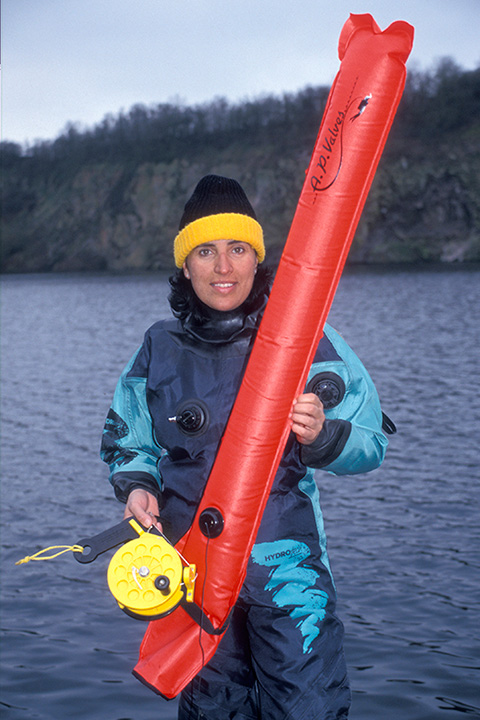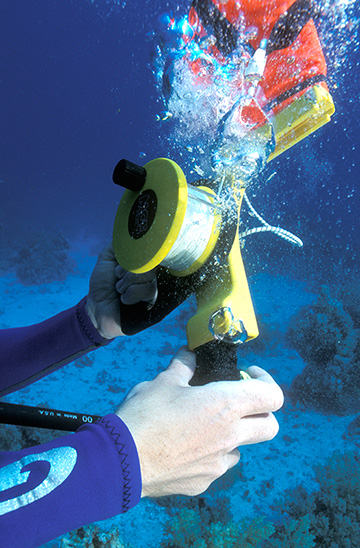Sending Your Sausage SafelyContents of this Issue: Two Fish Divers, Lembeh and Bunaken, Indonesia Diving in Lembeh Can Be Infectious! St. Vincent, Maldives, Roatan, Belize Your Travel Reports Are Important A New Feature for Your Travel Reports Diving Gear to Stand Well Clear Of! Suunto/Aqualung Computer Lawsuit Continues A Creative Way to Create Marine Parks and the U.S. Must Step Up A Safety Sausage Can Save Your Life Solutions for Rescue When Lost at Sea False Liability Release Answers May Have Cost a Widow Dearly Mares Tests Full-Face Snorkeling Masks in the Light of Snorkeling Deaths Does Your Light Cause Critters Harm? More Views on AOW Certifications Editorial Office: Ben Davison Publisher and Editor Undercurrent 3020 Bridgeway, Suite 102 Sausalito, CA 94965 letting them know where you are before you surface from the April, 2018 issue of Undercurrent
After a dive, attracting the attention of your pick-up boat when you're at the surface can be crucial to your survival. Undercurrent often reports stories of divers who drift away because they aren't spotted, so a using a device to make you easily seen, rather than just hoping your head poking through the waves is visible, is essential. A safety sausage is the common attention grabber. In its simplest form, it is a long, thin plastic tube that one inflates at the surface by squirting air from the regulator (preferably the octopus) into it. Many liveaboard divers and others prefer a more sophisticated safety sausage, a delayed surface marker buoy (DSMB) that can be sent to the surface while you are pausing at a safety stop (or even deeper) so that your boat driver is waiting for you when you hit fresh air. One holds a line attached to the open end of this surface marker buoy, and squirting air into it at 20 feet (6m) deep will send it to the surface. However, one must keep the line taut. Otherwise, it will fall over on the surface and soon be back to join you. Some of these delayed surface marker buoys have a small weight attached to prevent that from happening. Some have a small weight attached to the line so that you can drop it and not get entangled. (It's often a good idea to flake the weighted line in a small pouch ready for use when you need it.)
Some DSMBs have a closed end, an over-pressure valve and an oral filling tube. You must take your regulator out of your mouth to blow into it, something that many divers are reluctant to do. Another design allows you to disconnect your BC hose and connect it to a DSMB. However, so attached, you could easily get dragged up with the buoy as it ascends - not a good idea! Usually divers use a DSMB in conjunction with a winder reel or a simple spool. After you send up the buoy, you can bring in the line during a controlled ascent. Although you can send the DSMB up from a greater depth, you must be careful that the reel doesn't jam or the spool doesn't get tangled. A cardinal rule: never attach the buoy, the reel or the line to yourself or your other equipment when deploying a surface marker buoy. Some DSMBs have an inflation device, either a CO2 cartridge or a small cylinder of air (sometimes called a crack-bottle) that you have previously filled from your tank. Launching these devices is simple. However, be aware that 1) the sudden loss of the crack-bottle weight will add to your buoyancy and 2) you risk entanglement with the line you attached to it. The most popular design of DSMB is a long sausage shape with a constricted opening so that air cannot escape at the surface. You can fill it from your tank via your octopus rig or your main regulator, or exhale into it. Entanglement is the biggest potential problem encountered by divers sending up buoys from depth. When stuffing your octopus into the open end of the sausage, both hands are busy, and the reel might release more line than you want. You need to be especially careful. Once you have inflated the DSMB, it will hurtle toward the surface, and you must be sure you won't be dragged with it. The get this procedure right, practice it then stick with your method. Another way to inflate a DSMB is to exhale into it. With the reel in your right hand, hold the open end of the unfurled buoy in your left hand, letting the buoy body float above you. Take a full breath from your regulator, adjusting your BC to counteract the increase in buoyancy. Turning your head to one side, breathe out, allowing the exhaled air to route through the exhaust-T of the regulator into the open end of the sausage. Your buoyancy will not change because the air was either in you or the DSMB. You will have as much time as you need (without inhaling again) to get organized with the reel and send the DSMB on its way. Then continue breathing, which is easy because your regulator has never left your mouth! Well-practiced divers can even do this single-handed, holding the line on a spool in the same hand as the buoy to be released. It is even easier to launch a DSMB from depth in this way because, for example, a DSMB only a quarter-filled with a small breathe at 100 feet (30m) will be full at the surface after the air expands. This is a common procedure for wreck divers. By using a DSMB on a line, your pick-up boat will know exactly where you will be surfacing and your long waits worrying will be a thing of the past. -- John Bantin |

I want to get all the stories! Tell me how I can become an Undercurrent Online Member and get online access to all the articles of Undercurrent as well as thousands of first hand reports on dive operations world-wide
| Home | Online Members Area | My Account |
Login
|
Join
|
| Travel Index |
Dive Resort & Liveaboard Reviews
|
Featured Reports
|
Recent
Issues
|
Back Issues
|
|
Dive Gear
Index
|
Health/Safety Index
|
Environment & Misc.
Index
|
Seasonal Planner
|
Blogs
|
Free Articles
|
Book Picks
|
News
|
|
Special Offers
|
RSS
|
FAQ
|
About Us
|
Contact Us
|
Links
|
3020 Bridgeway, Ste 102, Sausalito, Ca 94965
All rights reserved.


 Of course, the loss of that weight and the buoyancy of ascending DSMB can cause problems. You don't want to be dragged up by the ascending buoy. The trick is to deploy the buoy while staying exactly where you are in the water column. You should simply be able to control your buoyancy with your breathing.
Of course, the loss of that weight and the buoyancy of ascending DSMB can cause problems. You don't want to be dragged up by the ascending buoy. The trick is to deploy the buoy while staying exactly where you are in the water column. You should simply be able to control your buoyancy with your breathing. 